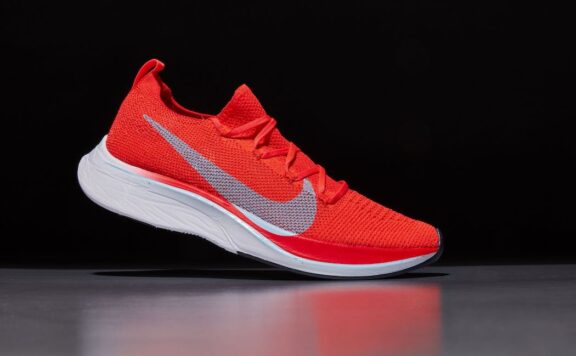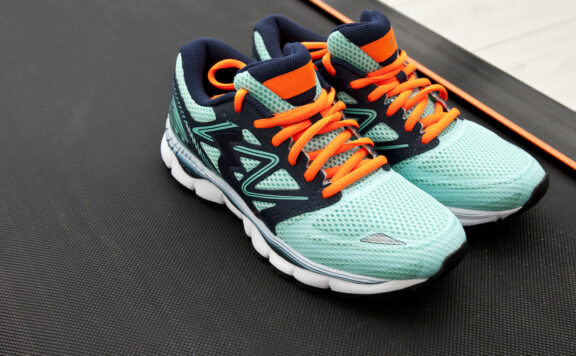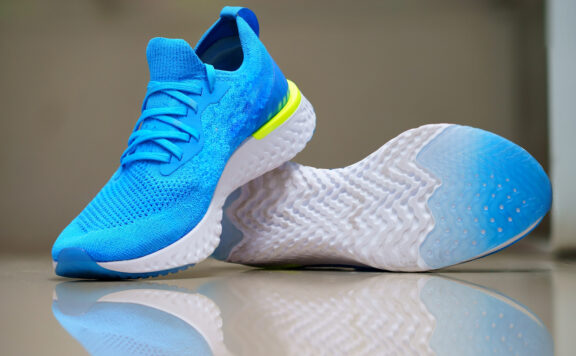Finding the perfect pair of running shoes can be quite intimidating, especially if you don’t know what you are looking for.
There are simply too many things to consider, whether it relates to different shoe components, functionality, or even brands.
But you don’t need to be an expert on running shoes to find the right pair for yourself. All you need is the perfect running shoe guide.
And that’s why we’re here.
Our ultimate running shoe guide breaks shoes down by three main components groups – the upper, the midsole, and the outsole. We also break down and explain the technical shoe jargon that really matters.
So, let’s start at the top and work our way down!
Elements of the Upper
The upper is responsible for covering your foot in a way that ensures a snug, secure fit while providing stability. Let’s take a look at what it’s made up of and why it matters so much.
Upper Fabric
In racing shoes, the upper fabric is usually made up of fine, engineered mesh (that has been patterned for strength and flexibility) or knit that provides a close-to-foot, sock like feel.
Overlay
The overlay consists of multiple layers of fabric that provides a structure and stability to the upper. It is often made of reflective materials to boost visibility, and may include the shape of the brand’s emblem or logo. However, today many brands are forgoing overlays to reduce the shoe’s weight.
Tongue
The tongue is an important part of all shoes. Not only does it protect the top of your foot from the laces, it also prevents debris and gravel from entering your shoe.
While the tongue is always connected to the upper near the toes, there are two variations. A gusseted tongue connects to the upper from the sides, and is more effective at keeping the debris out and securely conforming to your foot. However, it is considerably more difficult to put on and take off.
A burrito tongue, on the other hand, is only connected to one side. It is also relatively effective at blocking junk, but is much easier to put on and take off than the gusseted type.
Toebox
Located at the front of the shoe, the toe box protects the toes and should have enough room for them to splay and prevent them from blistering.
Heel Counter
This is a piece of plastic or fabric that cradles the heel and provides it with side-to-side support.
Elements of the Midsole
Made from a rubber-like foam, the midsole is also called the core of the shoe, and is responsible for providing cushioning and energy return.
The type of the foam used to create the shoe plays a huge part in the functionality, comfort, and flexibility of the shoe. Let’s take a look at the different types of foam commonly used in the industry.
1. EVA
Ethylene vinyl acetate (that comes in both white and gray layers), has long been the standard midsole foam, especially because of its softness, flexibility, and low production cost. However, it does have a downside. Cold weather often causes it to become rigid and compress over mileage, and hence cause it to lose its bounce.
2. PU
PU, or polyurethane is considerably less sensitive to temperature and much more durable than EVA. While this does give it a bouncier feel, PU is also roughly 50% heavier than EVA.
3. TPU
Thermoplastic polyurethane is a heated and reformed version of PU that is quite popular today. Brands like Adidas and Saucony make use of a two step process, first making the TPU beads and then fusing them together to create a more durable, flexible and bouncier foam than EVA and PU. Naturally, this also makes TPU a quite heavier foam than EVA.
4. Pebax
Polyether block amide (Pebax) is a relatively newer type of foam that gained recognition after it was used in the Nike Vaporfly 4%. A highly responsive foam, Pebax retains its flexibility and energy return even in cold conditions, and is up to 20% lighter than TPU.
Elements of the Outsole
Put simply, the outsole is the bottom of the shoe, and is usually made of solid or blown (air injected) rubber. Solid rubber is more durable while blown rubber is more flexible and adds to the cushioning effect of the shoe.
If your running shoes are meant for the road, the outsole will be highly segmented with a flatter tread and flex grooves. On the other hand, if the shoe is meant for trail, they will have a more aggressive lug pattern for improved grip on the rugged terrain.
Let’s look at some of the important elements and functions of the outsole.
Footbridge
Also called a shank, the footbridge is located between the heel and the forefoot. It provides the shoe with stability and reduces twisting.
Rock Plate
Made from plastic, these protective pieces are placed between some trail shoes mid and outsoles for additional protection on rocky and rough trails.
Beveled Heel
The beveled heel is basically a heel that has been rounded, or angled in the back to lessen the heel impact upon landing.
Decoupled heel
A decoupled heel is a heel that has been split into two. This allows it to absorb more amounts of shock, and in turn provide a smoother transition when the heel lands on the pavement.
Shoe Jargon
Last
The last is a manufacturer’s model that reflects or mimics foot shapes. Typically, there are three kinds – curved, semi curved and straight. Racing shoes are generally curved for arch support, while stability shoes are straight. The majority of shoes are semi curved.
Heel Lift
Also called offset or drop, this is the difference in height between the forefoot and heel. Most shoes are 8mm to 10mm, as a zero to 4mm-drop depicts a natural foot position. However, many runners find a higher heel lift more comfortable.
Energy Return
This is the amount of bounce or spring inside the shoe after your foot lands on the ground. A higher percentage of energy return gives you a bouncier feeling, however, there are other factors at play as well. These include the runners weight, gait, and form.
Stability
Runners often overpronate – their feet roll too far inward during their stride. Running shoes often have in-built stability tech to assist such runners.
And that’s it – everything you need to know about your running shoes!







